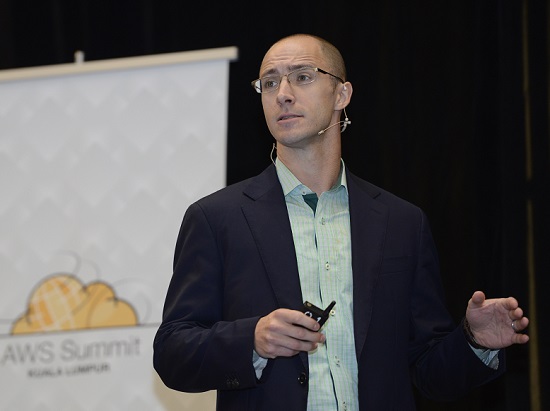CIOs tend to over-think cloud adoption: Ex-Dow Jones CIO
By Edwin Yapp June 2, 2015
- ‘Analysis-paralysis’ trap exists; don’t over-think it, just try it
- CIOs to be more customer-oriented in a cloud-enabled world

IT’S not every day you meet a senior IT executive who’s roaring to get into cloud computing, but for Stephen Orban (pic above), head of enterprise strategy at Amazon Web Services (AWS), adopting cloud computing was one of the best decisions he ever made as an ‘IT guy.’
But then, wouldn’t you expect that out of an executive who works for AWS?
Orban, however, isn’t your average vendor executive, having spent the better part of his career as an end-user in large media companies.
Prior to joining AWS, Orban was the chief information officer (CIO) of Dow Jones & Company, where he introduced modern software development methodologies, reduced costs, and administered a ‘cloud-first’ policy within the organisation.
These transformational changes accelerated product development cycles and increased productivity across all lines of Dow Jones’ business, including The Wall Street Journal (WSJ), MarketWatch.com, Dow Jones Newswires, and Factiva, according to his curriculum vitae.
Before that, he spent 11 years at Bloomberg LP, moving through various roles before landing the job of chief technical officer of Bloomberg Sports in 2008.
Orban, who was the main keynote speaker at AWS’ inaugural Summit and Developer Day in Kuala Lumpur recently, said if there is one thing he learnt in IT, it was that too many senior IT executives over-think things when it comes to the cloud and whether they should adopt it or not.
“I do find some companies fall into the ‘analysis paralysis’ trap – that they try to solve problems before they encounter them,” he said.
“Doing this, it will take you forever to get onto the cloud as you’re planning to mitigate against problems that may or may not happen.
“Don’t over-think it. Give it a shot and prove to yourself whether you can do it or not, as it can be just a few days’ exercise. Try something and I’m pretty confident you’ll understand why so many people are heading in this direction,” he added.
Easier said than done, perhaps, but having ‘been there and done that,’ Orban is very confident of his advice and urged others at the helm of their own IT organisations to take the plunge.
In an exclusive interview with Digital News Asia (DNA), Orban also shared his views on a wide variety of topics, including his experiences in running a cloud-based organisation, the changing role of the CIO, other impediments in adopting the cloud, and some best practices for doing so.
Below are excerpts of the interview.
DNA: Tell us a little about your job scope whilst at Dow Jones & Company, and why you took it to the cloud?
Orban: Dow Jones & Company has a 125-year history and it was being challenged by a range of free online publications.
I spent the last three years as a CIO in several roles, including product development, and my main charter was to focus the company on technology and help usher in the digital era. Going to the cloud was natural as I was there at the right place and at the right time for such a transformation to happen.
DNA: What kind of projects did you lead in order to transform Dow Jones while you were there?
Orban: Dow Jones’ business-to-business (B2B) arm is in Factiva and Dow Jones Newswires, and our business-to-consumer (B2C) products such as the WSJ and MarketWatch.com.
One can make an argument that Factiva and Dow Jones Newswires manage a lot of the world’s wealth, while the people who subscribe to WSJ and MarketWatch are the people who own that wealth.
Our CEO (chief executive officer) at that time wanted to create a chat app to bridge those two communities, so we could create a compelling offering.
With cloud technology, we were up and running in a few months, and it only cost us a couple of hundred dollars a month. In my experience, a similar project like that when I was with Bloomberg would have cost thousands of dollars just to try, let alone to implement.
This project served as our ‘lighthouse’ project to pave the way and convince some of the top executives in the organisation that such projects could work.
DNA: What happened after you ran the a project? What were your next steps? How did you continue cultivating an agile IT organisation within Dow Jones & Company?
Orban: I started to create a DevOps organisation. This is when I started to change the organisation structure of my entire department in order to facilitate adopting more cloud and open source technology.
This centre of excellence’s mandate was to create a customer service-oriented organisation so that people who are developing their projects could come to the DevOps group and get good customer service from within my organisation.
In reality, there often is friction between app developers and infrastructure groups, and I was very keen to avoid that. Sometimes a system of checks and balances is useful, but I was also aware that there is that imaginary line that, once crossed, becomes toxic and unproductive.
So it was very important for me to send the message that the DevOps group was there to help everyone and they are going to provide best practices and governance in the way they use the cloud.
Next Page: C-level resistance is futile, plus advice for CIOs


